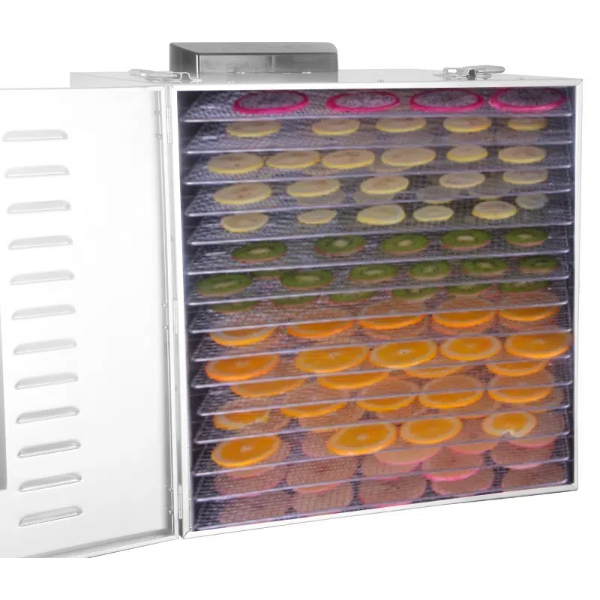
Content Menu
● Introduction
● Understanding Food Drying Machines
● The Process of Food Drying
● Safety Considerations in Food Drying
● Innovations in Food Drying Technology
● Applications of Food Drying Machines
● Conclusion
● Frequently Asked Questions
>> 1. What are the benefits of using a food drying machine?
>> 2. How do I choose the right food drying machine?
>> 3. Can I dry any type of food in a food dryer?
>> 4. What safety measures should I take when using a food drying machine?
>> 5. How does a heat pump dryer differ from traditional dryers?
Introduction
Food preservation is a critical aspect of food processing, ensuring that products remain safe and nutritious for consumption over extended periods. Among various preservation methods, food drying stands out for its effectiveness and simplicity. Food drying machines have revolutionized this process, allowing for efficient and consistent drying of various food items. This article explores the significance of food drying machines, their operation, safety considerations, and innovations in technology.

Understanding Food Drying Machines
Food drying machines, also known as dehydrators, are appliances designed to remove moisture from food items. They come in various types, including electric dehydrators, solar dehydrators, and heat pump dryers. Each type operates on the principle of reducing moisture content to inhibit the growth of bacteria, yeast, and mold, thereby extending the food's shelf life.
Electric dehydrators are the most common, utilizing fans and heating elements to circulate warm air around the food. Solar dehydrators harness sunlight, making them an eco-friendly option. Heat pump dryers, a newer technology, use a refrigeration cycle to extract moisture efficiently while maintaining lower temperatures, which helps preserve the food's nutritional value.
The Process of Food Drying
The food drying process involves several steps:
1. Preparation: Foods are washed, peeled, and cut into uniform pieces to ensure even drying.
2. Blanching: Some vegetables may require blanching to deactivate enzymes that can affect flavor and color.
3. Drying: The prepared food is placed in the drying machine, where controlled heat and airflow remove moisture.
4. Cooling and Packaging: Once dried, the food is cooled and packaged in airtight containers to prevent moisture reabsorption.
Factors such as temperature, humidity, and airflow significantly influence the drying process. For instance, fruits typically dry at lower temperatures (around 135°F), while vegetables may require higher temperatures (around 145°F) to ensure thorough drying.

Safety Considerations in Food Drying
Safety is paramount in food processing, including drying. Potential hazards associated with food drying machines include:
1. Electrical Risks: Ensure that the machine is properly grounded and that cords are in good condition.
2. Fire Hazards: Regularly clean lint and debris from the machine to prevent overheating and potential fires.
3. Food Safety: Monitor drying times and temperatures to ensure that food is dried adequately to prevent spoilage.
Best practices for safe operation include following the manufacturer's instructions, conducting regular maintenance, and keeping the drying area clean and organized.
Innovations in Food Drying Technology
Recent advancements in food drying technology have focused on improving energy efficiency and sustainability. Heat pump dryers, for example, are gaining popularity due to their ability to operate at lower temperatures while effectively removing moisture. This not only saves energy but also helps retain the food's nutritional content and flavor.
Additionally, many modern food drying machines come equipped with digital controls, allowing users to set precise drying times and temperatures. This level of control enhances the drying process, ensuring consistent results.
Applications of Food Drying Machines
Food drying machines are widely used in both commercial and home settings. In commercial food production, they play a vital role in creating dried fruits, vegetables, and snacks, catering to the growing demand for healthy, shelf-stable products. Home users benefit from these machines by preserving seasonal produce, creating homemade snacks, and reducing food waste.
Case studies of successful food drying operations highlight the versatility and profitability of these machines. For instance, small-scale farmers have utilized food dehydrators to add value to their crops, creating a market for dried fruits and vegetables.
Conclusion
Food drying machines are essential tools in the realm of food preservation, offering numerous benefits in terms of safety, efficiency, and product quality. As technology continues to evolve, these machines will likely become even more integral to both commercial and home food processing. Embracing innovations in food drying technology can lead to better preservation methods, ensuring that food remains nutritious and delicious for longer periods.

Frequently Asked Questions
1. What are the benefits of using a food drying machine?
Food drying machines preserve nutrients, enhance flavor, and extend shelf life.
2. How do I choose the right food drying machine?
Consider capacity, energy efficiency, and specific features like temperature control.
3. Can I dry any type of food in a food dryer?
Most fruits, vegetables, and herbs can be dried, but some foods may not yield good results.
4. What safety measures should I take when using a food drying machine?
Regularly clean the machine, monitor drying times, and ensure proper ventilation.
5. How does a heat pump dryer differ from traditional dryers?
Heat pump dryers operate at lower temperatures, making them more energy-efficient and safer.












